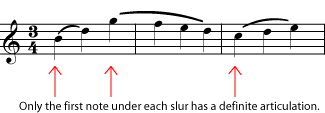| << Chapter < Page | Chapter >> Page > |
Accents - An accent requires that a note stand out more than the unaccented notes around it. Accents are usually performed by making the accented note, or the beginning of the accented note, louder than the rest of the music. Although this is mostly a quick change in dynamics , it usually affects the articulation of the note, too. The extra loudness of the note often requires a stronger, more definite attack at the beginning of the accented note, and it is emphasized by putting some space before and after the accented notes. The effect of a lot of accented notes in a row may sound marcato .

A slur is marked by a curved line joining any number of notes. When notes are slurred, only the first note under each slur marking has a definite articulation at the beginning. The rest of the notes are so seamlessly connected that there is no break between the notes. A good example of slurring occurs when a vocalist sings more than one note on the same syllable of text.

A tie looks like a slur, but it is between two notes that are the same pitch. A tie is not really an articulation marking. It is included here because it looks like one, which can cause confusion for beginners. When notes are tied together, they are played as if they are one single note that is the length of all the notes that are tied together. (Please see Dots, Ties, and Borrowed Divisions .)

A portamento is a smooth glide between the two notes, including all the pitches in between. For some instruments, like violin and trombone , this includes even the pitches in between the written notes. For other instruments, such as guitar , it means sliding through all of the possible notes between the two written pitches.

Although unusual in traditional common notation , a type of portamento that includes only one written pitch can be found in some styles of music, notably jazz, blues, and rock. As the notation suggests, the proper performance of scoops and fall-offs requires that the portamento begins (in scoops) or ends (in fall-offs) with the slide itself, rather than with a specific note.

Some articulations may be some combination of staccato, legato, and accent.
Marcato , for example means "marked" in the sense of "stressed" or "noticeable". Notes marked

Plenty of music has no articulation marks at all, or marks on only a few notes. Often, such music calls for notes that are a little more separate or defined than legato, but still nowhere as short as staccato. Mostly, though, it is up to the performer to know what is considered proper for a particular piece. For example, most ballads are sung legato, and most marches are played fairly staccato or marcato, whether they are marked that way or not. Furthermore, singing or playing a
phrase with musicianship often requires knowing which notes of the phrase should be legato, which should be more separate, where to add a little

Notification Switch
Would you like to follow the 'Reading music: common notation' conversation and receive update notifications?